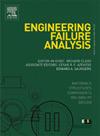高温高压高速气流对金属表面侵蚀破坏机理的研究
IF 5.7
2区 工程技术
Q1 ENGINEERING, MECHANICAL
引用次数: 0
摘要
高温、高压和高速气流会加速金属部件的材料损耗,缩短其使用寿命。为了探索这种侵蚀破坏背后的机理,我们采用了逐步实验的方法,使用高压、高速氩气和高温、高压、高速推进气体侵蚀枪钢试样的表面。研究集中于热、化学和机械因素的相互作用。使用扫描电子显微镜-能量色散光谱仪(SEM-EDS)、X 射线衍射仪(XRD)和电子反向散射衍射仪(EBSD)对侵蚀后的表面进行了分析,以评估表面形态、元素分布和相组成。研究结果表明,材料流失的主要原因是气流冲刷的机械效应。虽然最初对光滑表面的影响很小,但一旦出现裂缝,表面变得粗糙,这种影响就会变得很大。这导致了持续的侵蚀过程和表面材料的磨损现象。热作用和化学作用产生的白层分为两个不同的层。白色外层由奥氏体、雪明体和氧化铁组成。它非常脆,容易破碎和剥落。白色内层由马氏体和奥氏体的细粒混合物组成。在快速而强烈的热传递过程中,浅层受到热应力,形成细小裂纹,削弱了表面的完整性。最终,在三个因素的共同作用下,部件表面发生断裂并向内退化。本文章由计算机程序翻译,如有差异,请以英文原文为准。
Investigation into the erosion damage mechanism of High-Temperature, High-Pressure, and High-Speed gasflow on metal surfaces
High-temperature, high-pressure, and high-speed gasflow can accelerate material loss on metal components, shortening their service life. To explore the mechanisms behind this erosion damage, a stepwise experimental approach was conducted, using high-pressure, high-speed argon gas and high-temperature, high-pressure, high-speed propellant gas to erode the surfaces of gun steel specimens. The investigation centered on the interaction of thermal, chemical, and mechanical factors. An analysis of the surface after erosion was conducted using scanning electron microscopy-energy dispersive spectrometry (SEM-EDS), X-ray diffractometry (XRD), and electron backscatter diffraction (EBSD) to evaluate the morphology of the surface, distribution of elements, and composition of phases. The findings indicate that the primary cause of material loss is the mechanical effect of the gasflow scouring. While the initial impact on smooth surfaces is minimal, it becomes significant once cracks develop and the surface becomes rough. This leads to a continuous erosion process and a wear phenomenon of the surface material. The white layer promoted by the thermal and chemical actions is partitioned into two distinct layers. The outer white layer is made up of the austenite, the cementite, and the iron oxide. It is very brittle, easily broken, and flaked. The inner white layer consists of a fine-grained mixture of martensite and austenite. During the rapid and intense heat transfer, the shallow layer experiences thermal stresses, forming small cracks that weaken the integrity of the surface. Ultimately, due to the combined impact of three factors, the surface of the component fractures and deteriorates inwardly.
求助全文
通过发布文献求助,成功后即可免费获取论文全文。
去求助
来源期刊

Engineering Failure Analysis
工程技术-材料科学:表征与测试
CiteScore
7.70
自引率
20.00%
发文量
956
审稿时长
47 days
期刊介绍:
Engineering Failure Analysis publishes research papers describing the analysis of engineering failures and related studies.
Papers relating to the structure, properties and behaviour of engineering materials are encouraged, particularly those which also involve the detailed application of materials parameters to problems in engineering structures, components and design. In addition to the area of materials engineering, the interacting fields of mechanical, manufacturing, aeronautical, civil, chemical, corrosion and design engineering are considered relevant. Activity should be directed at analysing engineering failures and carrying out research to help reduce the incidences of failures and to extend the operating horizons of engineering materials.
Emphasis is placed on the mechanical properties of materials and their behaviour when influenced by structure, process and environment. Metallic, polymeric, ceramic and natural materials are all included and the application of these materials to real engineering situations should be emphasised. The use of a case-study based approach is also encouraged.
Engineering Failure Analysis provides essential reference material and critical feedback into the design process thereby contributing to the prevention of engineering failures in the future. All submissions will be subject to peer review from leading experts in the field.
 求助内容:
求助内容: 应助结果提醒方式:
应助结果提醒方式:


